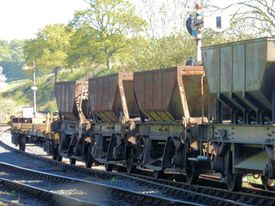London Transport ‘Herring’ Ballast Hopper Wagons
| London Transport ‘Herring’ Ballast Hopper Wagons | |
|---|---|
 Three Herring ballast hoppers in an engineers train | |
| Built By | See table |
| Status | In service |
| Number | See table |
| History | |
| Built | See table |
| Diagram | P6 / P20 |
| Type | 4-wheel steel ballast hopper |
| Capacity | 20 tons |
| Telegraphic code | HERRING |
| 1984 | Arrived on the SVR |
| 1985 | GW 150 main line appearance |
The SVR’s wagons are numbered as follows:
| Number | Built | Built by | Wagon Survey | Notes |
|---|---|---|---|---|
| HW 410 | 1938 | GRCW | Link | |
| HW 411 | 1938 | GRCW | Link | |
| HW 436 | 1965 | BR Shildon | Link |
Contents
Service
The two early examples were originally ordered by the London Passenger Transport Board in 1936 for use on planned extension works on London Underground such as the extension of the Northern Line to Potters Bar. These works were cancelled in 1938 due to the impending war. The third example was not built until the mid-1960s.[2]
Preservation
The three ballast hoppers were acquired by SVR(H) in early 1984 and were initially intended for use in completing the extension to Kidderminster. Delays in receiving the LRO meant they were marooned in a goods yard at Shirebrook in Derbyshire, only arriving on the morning of 23 July 1984, the Monday of the final week before opening. They were immediately brought into use, greatly speeding up the final ballasting, lifting packing and slueing which was required at Kidderminster.[2][3]
In 1985, 410 and 436 appeared on the main line when they were used used in the GW 150 demonstration freight train which ran to Newport behind GWR freight loco 2857.[4]
The wagons saw regular use on Permanent Way duties on the railway until superseded by other larger ballast hoppers, including a 24 ton BR 'Dogfish' Ballast Hopper Wagon and six 40 ton BR 'Seacow' 40t Ballast Hoppers. On 8 May 2021 they were moved to the Stourport Triangle.


